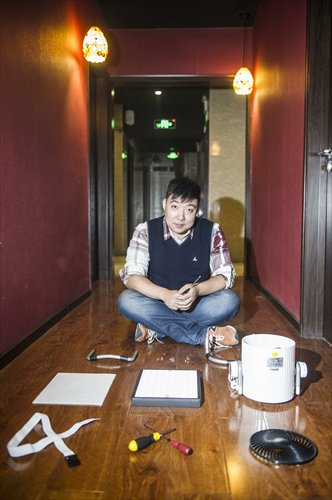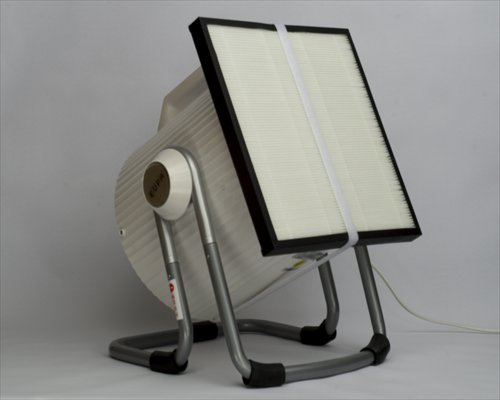Cheap and fresh

Zhang Peng, a Beijing resident, prepares to put together a do-it-yourself air purifier. Photo: Li Hao/GT
Suffering from the interminable heavy smog that was smothering Beijing, 32-year-old Zhang Peng was filled with joy when the parts for a simple home-made air filter arrived at his house, the day after he ordered them from an online shop.
It took him about half an hour to put together the contraption, made with a fan and a high-efficiency particulate absorption (HEPA) air filter, using a design he found online.
Zhang noticed a difference within two hours, finding the air had become "pleasant and clean" in his 20-square-meter bedroom.
Zhang was one of many people who made DIY air purifiers to combat China's smog over the past month, as air pollution soared to historic record highs.
Airing grievance
"The recent smog has been so heavy that my family and I just could not stand it and had to take action," said Zhang, who has a 7-year- old boy and a 3-year-old daughter.
Last week, Beijing was shrouded with record pollution. The reading for deadly tiny PM2.5 particles soared to 440 for six consecutive days.
Zhang was inspired by an American PhD student, Thomas Talhelm, who put directions on his website on how to make an air purifier with only 166 yuan ($27).
"The price of the air purifiers differs greatly, ranging from several hundred yuan to 15,000 yuan," said Zhang, who took apart a very expensive air purifier produced in Switzerland that he had in his office and was surprised to find that its structure is very simple.
"It is not that complicated, just a filter and a fan," said Zhang. "I decided I would like to make one by myself."

The Cannon, the second DIY air purifier designed by the Smart Air team. Photo: Courtesy of the Smart Air team
Mother of invention
Talhelm, the 28-year-old American who inspired Zhang, did not come to China to work on air filters. As a PhD student in psychology at the University of Virginia, Talhelm was in China on a Fulbright scholarship researching cultural differences between northern and southern China. But when the air in Beijing took a turn for the worse in January 2013, it set him on a path that ended with him telling the world about a simple DIY solution for clean air.
"I really never worried about the air inside my home, until the airpocalypse in January of last year," said Talhelm.
First, Talhelm wanted to know if purifiers actually work. He was convinced after reading air purifiers tests on the blog Beijing Health by Dr Richard Saint Cyr, an American physician working in Beijing in the United Family Healthcare hospital.
It did not take long before Talhelm found that a simple HEPA filter could remove 99 percent of much of the dangerous particulate pollution. So Talhelm bought a HEPA filter from a manufacturer and strapped it to a fan he had in his home. The total cost was 166 yuan, a twentieth of a popular foreign model recommended by Saint Cyr.
Talhelm drew on his PhD background to test his new creation and started doing experiments. He bought a particle counter and did tests. "This simple fan and HEPA filter was significantly reducing particulate pollution in my home. Over multiple overnight tests, it removed an average of 92 percent 2.5 micrometers and above, compared to a Blue Air 203/270 E, which removed 96 percent in the same room for the same amount of time. This simple DIY filter was almost as effective as the expensive brands," said Talhelm.
In July, Talhelm published his data online, along with instructions for how to make the DIY filter.
The response was so positive that Talhelm teamed up two like-minded friends to bulk order the parts and ship the DIY components directly to people. They called their project Smart Air.
"Every week our team gets emails from people asking about the project," said Anna Guo, co-founder of Smart Air, adding that by January, monthly revenue reached 300,000 yuan, with the highest single day reaching 40,000 yuan.

Thomas Talhelm teaches participants how to make air filters during a workshop. Photo: Courtesy of the Smart Air team
Constant tinkering
Guo Shouping, a 31-year-old who works at a financial IT company in Beijing, is a DIY hobbyist.
Guo spent three evenings to create his first rectangle box-like air purifier last December.
"I change the 32-layer non-woven fabric every week, which is put above the HEPA filter to absorb the particles and extend the life of the filter," said Guo.
Unlike the blueprints used by Talhelm and Zhang, Guo put activated carbon between the fan and the HEPA filter, which can absorb organic particles like certain types of gases harmful to people's health.
Guo is now thinking about how to make his design more elegant with fewer potential safety hazards.
Talhelm admitted that his original design is not perfect and still needs some improvements. His team has developed a new version called the Cannon, with a stronger fan that can clean a greater volume of air than the original design.
Doctor approves
Saint Cyr told Metropolitan that he tested Talhelm's design and found it effective.
This winter, Saint Cyr tested Talhelm's two DIY air filters in his home, and the data showed that these machines can work well, especially in small rooms, eliminating at least 80 percent of the PM2.5.
"My results were almost as good as the much more expensive machines! I think it's very encouraging," said Saint Cyr.
"Air pollution affects all of us, but the hard truth is that a majority of people in China can't afford commercial air purifiers. All good air purifiers use a HEPA filter and a strong fan, so making a cheaper one yourself may not be as effective as some of the better brands, but it's a lot better than nothing at all," said Saint Cyr. However, Saint Cyr also recommended that people who can afford it buy commercial machines, because they are more reliable, quieter, and have protection against volatile organic compounds, odors and smoke.
"If I could afford commercial machines and needed to protect my child, I definitely would still choose a smaller machine from a well established company," he added.
Make your own air purifier
What you will need:
Circulating fan, HEPA filter bigger than the fan's circumference, pliers, thick string or twine, particle counter (optional).
Assembly instructions:
1. Remove grill from front of fan
2. Fasten HEPA filter onto front of fan using string
Tips on use:
1. Keep doors and windows closed
2. Keep out of reach of small children and pets
3. Replace HEPA filter every two to three months, or earlier when particulate matter is high
4. If buying a particle counter, test before purchasing
5. If going out for an extended period of time, turn off air purifier